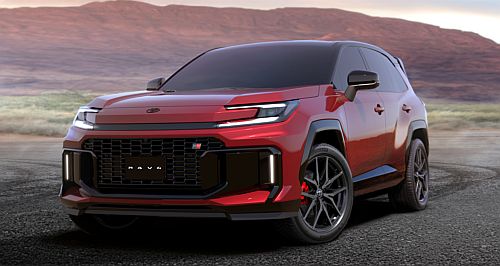Make / Model Search
News - ToyotaToyota says vehicle choice will lower emissionsBuying the vehicle you need, not want, will reduce transport emissions: Toyota18 Sep 2025 By MATT BROGAN TOYOTA Australia says that offering buyers a broad choice of powertrain options across current and forthcoming model ranges will help to reduce transport emissions – provided customers think carefully about buying a vehicle that best suits their needs.
Metropolitan buyers without the need for off-road ability vehicle may be better off buying a hybridised Kluger, and not a 300 Series LandCruiser; while family buyers who drive a HiLux and never tow or haul a load might be better served by a petrol-electric RAV4.
Speaking with GoAuto at a preview drive of the LandCruiser 300 Series Hybrid in Melbourne this week, Toyota Australia vice president of sales, marketing and franchise operations Sean Hanley said the importer would continue to provide as many powertrain types as was practical for the foreseeable future while urging buyers to consider the option that best suits their needs.
“At some point, cars are going to have to be looked at in terms of what they are used for in more detail than we ever have,” he proffered.
“In other words, you may have a LandCruiser with a powertrain that is really only for city people and then another LandCruiser that could be used for off-road work and towing.
“That’s how it is going to go.”
Mr Hanley suggested many new car buyers shopped a particular vehicle because of its size or image, while never fully utilising the capabilities that vehicle can offer.
He suggested that the New Vehicle Efficiency Standard (NVES), coupled with higher fuel prices, and road-user taxes would likely prompt a change in buyer attitudes, seeing powertrain types paired almost exclusively with the region in which they are used.
“That is exactly how it has to go in the future if you want to offset NVES,” he stated.
“There will come a point when a manufacturer says, ‘I’ve got X number of ICE engines, so where are they going to go?’.
“They are going to go to the farmer, they are going to go to the miner, or to the person that lives on an outback station.
“This is what people need to understand about our multi-pathway strategy – it is a progressive, forward step towards decarbonisation that provides vehicles people need, as opposed to those they want.
“Toyota will have a solution (for every type of buyer). That is the benefit of this strategy.”
Mr Hanley said vehicles powered by liquid fuels would continue to form a part of Toyota’s model mix for a long time to come, but said petrol-electric hybrid, plug-in hybrid, and battery electric models will capture an increasingly higher share of the new car market over the decade ahead.
“Turbocharged petrol and diesel engines will still have a role to play for some time in Australia for particular applications … but hybrid in all its forms will take the lion’s share of the new vehicle market in Australia in the coming years,” he suggested.
“In other words, we are not talking EV only – never have, never will. Will EVs play a role in the future? 100 per cent they will. It would be naïve to think otherwise.
“But they are not going to be 80 per cent of the market in the next three to five years? Maybe 30 per cent or a bit more, but that about it.
“We still have customers that want to tow (cara)vans, that still want their cars for leisure activities, that still need them for mining and agriculture, and other applications. We haven’t walked away from those customers – and we haven’t walked away from decarbonisation.
“Instead, we are doing it in a way that takes people on that journey with us.”
Mr Hanley’s comments come just weeks after the Australian Department of Climate Change, Energy, the Environment, and Water (DCCEEW) updated its plan to reduce greenhouse gases and noxious transport emissions.
Developed alongside the federal government’s National Electric Vehicle Strategy, the Powering Australia plan is said to provide a nationally consistent, comprehensive framework to consider supply, demand, and infrastructure needs for cleaner and cheaper vehicles in Australia.
In part, the plan will incentivise buyers looking to make the switch to low- or zero emissions vehicles while improving public charging infrastructure and access to home charging.
The DCCEEW says the transport sector is currently the third-largest emitter of greenhouse gases, accounting for around 22 per cent of Australian’s overall emissions.
It says passenger cars and light commercial vehicles contribute to 60 per cent of our transport emissions and over 10 per cent of Australia’s total greenhouse gas emissions.
NVES regulations and other policy changes are expected to see that figure start to decline around 2028 as a greater number of zero- and low-emissions vehicles take to our roads.
 Read more8th of September 2025  Ariya to help chart NVES course says NissanNissan to balance NVES targets with HEV and BEV but not at expense of Navara, Patrol4th of September 2025  Details firm on generation six Toyota RAV4PHEV powertrain and GR Sport grade arriving with new sixth generation Toyota RAV4 SUV5th of August 2025  Kia bets on small car resurgence with new BEVsKia Australia commits to more BEVs in bet NVES will shift Australians to smaller cars21st of July 2025  Hybrid Forester to help Subaru hit NVES targetsForester Strong Hybrid to help Subaru meet NVES targets: Australian general manager8th of July 2025  Emissions regulations drive up Mustang priceFord increases the list price of its Mustang sportscar to cover NVES emissions penalties |
Click to shareToyota articlesResearch Toyota Motor industry news |











Facebook Twitter Instagram